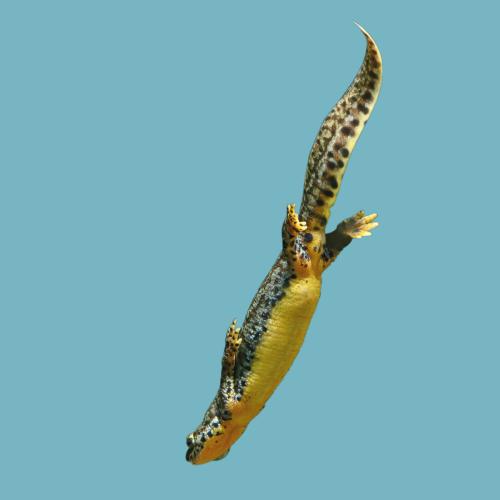You are here
EXHIBITION "EX-SITU - ARTISTIC POSITIONS ON ENDANGERED BIODIVERSITY AND THE COEXISTENCE OF SPECIES"
EX-SITU
Artistic Positions on Endangered Biodiversity and the Coexistence of Species
Exhibition and symposium in the National Museum of Bosnia and Herzegovina, Sarajevo
The opening of the exhibition is on Thursday, February 1, 2024 at 7:00 p.m. (Ethnology Department Building)
Exhibition duration: February 1 - March 3, 2024
Participating artists: Darko Aleksovski • Lamija Čehajić • Danube Transformation Agency for Agency • Anita Fuchs • Teuta Gatolin • Ernst Koslitsch • Polonca Lovšin • Ralo Mayer • Edith Payer • Irena Lagator Pejović • Nada Prlja • Lala Raščić • Oliver Ressler • Ivan Šuković • Adrienn Újházi / Nemanja Milenković • Anna Vasof • Driant Zeneli • Dardan Zhegrova
* * * * * * * * * * * * * * * * * * * * * * * * * * * * * * * * * * * * * * * * * * * * * * * * * * * * *
In the Vranica Mountains in the heart of Bosnia and Herzegovina lives the Bosnian Mountain Newt / Bosanski planinski triton. It must be added that it still lives there right now. The amphibian with the Latin name Ichthyosaura alpestris reiseri is considered to be an endangered species. The National Museum of Bosnia and Herzegovina is in the process of building a vivarium to protect the species ex situ. Its continued existence is intended to be secured within the walls of the museum, so that a later release into the wild is possible if the animal actually becomes extinct in its natural habitat.
It is high time for endeavours like this one. Looking back on his lifelong research and observations, biologist Edward O. Wilson states the following in Half-Earth: Our Planet’s Fight for Life, which was published in 2016: “Unless humanity acquires much more knowledge about global biodiversity and decides quickly to protect it, we will soon irretrievably lose most of the species that make up life on Earth.”
Human responsibility for the rapidly declining biodiversity can no longer be seriously questioned today. It is dramatic but actually not so surprising anymore when E.O. Wilson shares the insight that “current extinction rates are estimated to be one thousand times higher than they have been before the proliferation of the human race.”
The Bosnian Mountain Newt and the planned vivarium are the starting points for an exhibition of contemporary visual art in relation to the Natural History Department of the National Museum in Sarajevo. 18 artists and groups from Central and South-Eastern Europe present artworks which are situated in the field of tension between nature, human activity and (species) diversity versus endangered forms of life in the Anthropocene. References to science will be established directly in the Natural Sciences Department of the National Museum. Influences from multispecies discourse, other-than-human perspectives on living beings, and the changing conceptions of living beings in intellectual history and their appearances in mythologies of different cultural areas will play a role.
Another integral part of the project will be a one-day symposium with stakeholders from the field of visual arts, as well as some experts from the domain of natural sciences. This meeting of curators and cultural workers, artists and scientists is intended to promote the exchange in the context of the art exhibition topic as well as the National Museum’s engaged project to safe the Bosnian Alpine Newt and is aimed at a broad audience.
The present ecological challenges require solutions that call for a fundamental rethink and new approaches. Humans must learn “to make kin in lines of inventive connection as a practice of learning to live and die well with each other in a thick present” advises the historian of science and multispecies thought leader Donna Haraway, who has become very influential in recent years.
Or, speaking with the holistic and at the same time emphatically feminist approach of the philosopher and posthuman theorist Rosi Braidotti: “The environmental alternative is a new holistic thinking that links cosmology to anthropology and post-secular, mostly feminist spirituality, to assert the need for loving respect for diversity in both its human and non-human forms.”
Margarethe Makovec & Anton Lederer
Curators of the project
Thanks are due for numerous references to artistic works: Irena Borić, Adela Demetja, Irfan Hošić, Hristina Ivanoska / Yane Calovski / Jovanka Popova, Ajete Kërqeli / Nita Zeqiri, Andrea Palašti, Natalija Vujošević
* * * * * * * * * * * * * * * * * * * * * * * * * * * * * * * * * * * * * * * * * * * * * * * * * * * * *
This project by < rotor > centre for contemporary art, Graz, commissioned by the Cultural Department of the State of Styria following an initiative by the Austrian Federal Ministry for European and International Affairs is dedicated to the endangered Bosnian Mountain Newt.
